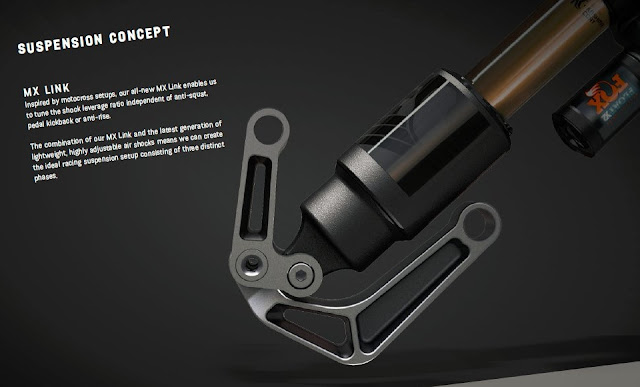When Specialized releases their new generation of Demo, people are shocking with its assymetrical frame, and curious about its performance. Beside of that, the new Demo offers slacker frame which is at the first sight the bike looks so hot.
After a while with the euphoria of the new Demo, Canyon fights back and releases the sexiest downhill bike, with their new downhill bike Canyon Sender. While their all-mountain/enduro machine the Strive is known as one of the best machines, the Sender comes with different sensation.
Let's look closer to the Sender.
SUSPENSION SYSTEM
Based on the company, Sender is using four-bar suspension system which they called as MX-Link Suspension System. This system inspired from motocross setup, and the link will enable to tune the leverage ratio. This moto-inspires link is also known as Triple-Phase-Suspension, i.e:
Phase 1: Air shocks require more force for activation than coil shocks. The MX Link transmits high power at the start of the stroke to overcome this. The result is outstanding responsiveness, small bump sensitivity and traction around the sag point equal to riding a coil shock.
Phase 2: Lower power through the mid-stroke provides a stable platform to reduce momentum loss. This enables the rider to actively pump for more track speed and make pinpoint line choices.
Phase 3: We combine the progressiveness of air shocks with a moderate progression at the end of the stroke to avoid blowing through the travel and give the suspension its bottomless feel.
(source - Canyon web)
GEOMETRY
Canyo calls the geometry of the Sender as Geo-Tune, which might be the combination between geometry and tuning. As we know, tuning is a way to adjust or make it 'in tune'. That's the concept and Canyon builds this geometry to be able to match with the terrain or tracks.
How?
In the faster and steeper terrain, it can use the standard 63 degree head. The chainstays also can be adjusted based on the rider's riding style. For technical race with tight corners, the shorter chainstays 430 mm setting can be used. While the riders want to get more speed, the longer 466 mm chainstays can be used.
MATERIAL
It's a bit different with another flagship machines from other brands, Canyon builds the Sender with the combination of carbon in the front triangle and alloy in the rear triangle. Some brands also use this combination like Polygon on their newest DH9 machine.
They have their own reason for using this combination, but they said that they don't seek for saving weight, but for the strenght and vibration damping. While the aluminum 6066 T6 material claims can handle the rough crash and damage.
Those materials then joined with high quality bearings, an industrial grade bearings to make it performs in the high level. The Sender has oversized bearings on the main triangle to deal with the high lateral force that may happen in this part.
How?
In the faster and steeper terrain, it can use the standard 63 degree head. The chainstays also can be adjusted based on the rider's riding style. For technical race with tight corners, the shorter chainstays 430 mm setting can be used. While the riders want to get more speed, the longer 466 mm chainstays can be used.
MATERIAL
It's a bit different with another flagship machines from other brands, Canyon builds the Sender with the combination of carbon in the front triangle and alloy in the rear triangle. Some brands also use this combination like Polygon on their newest DH9 machine.
They have their own reason for using this combination, but they said that they don't seek for saving weight, but for the strenght and vibration damping. While the aluminum 6066 T6 material claims can handle the rough crash and damage.
Those materials then joined with high quality bearings, an industrial grade bearings to make it performs in the high level. The Sender has oversized bearings on the main triangle to deal with the high lateral force that may happen in this part.










0 comments:
Post a Comment